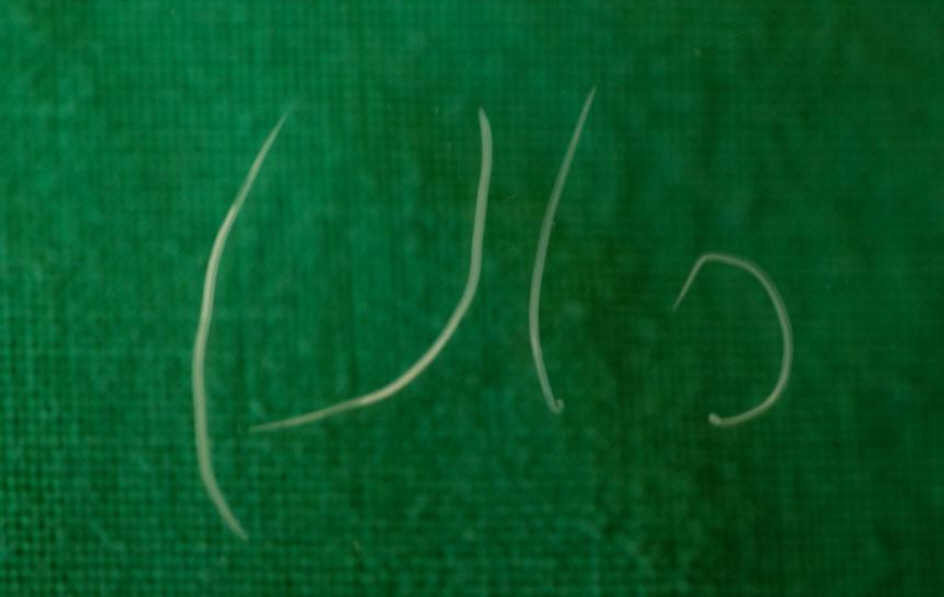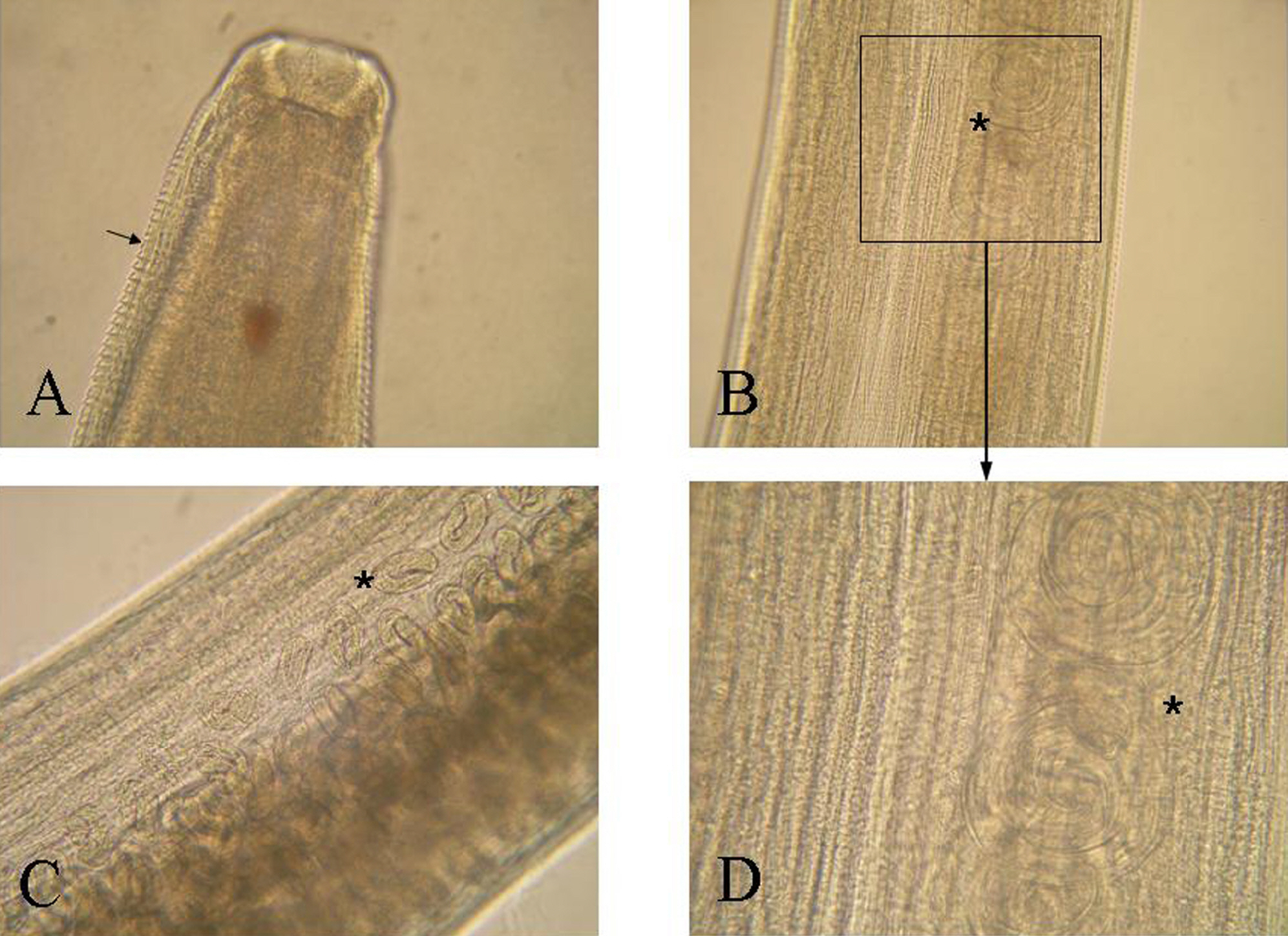J Korean Ophthalmol Soc.
2010 Jun;51(6):895-898. 10.3341/jkos.2010.51.6.895.
A Case of Thelazia Callipaeda Recurred At a One-month Interval
- Affiliations
-
- 1Department of Ophthalmology, Myongji Hospital, Kwandong University College of Medicine, Seoul, Korea.
- 2Department of Ophthalmology, Konkuk University Chungju Hospital, Chungju, Korea. Bnkang@kd.ac.kr
- KMID: 2213627
- DOI: http://doi.org/10.3341/jkos.2010.51.6.895
Abstract
- PURPOSE
To report a relapsed case of an intra-conjunctival Thelazia callipaeda infestation within one month.
CASE SUMMARY
A 59-year-old female patient presented with symptoms of itching and a sense of foreign substance in her left eye, which she had been experiencing for several days. Conjunctival hyperemia and follicle multiplication along with ten actively moving worms were identified and were extracted with forceps. The symptoms disappeared until 25 days later, when they recurred and five additional worms were extracted. All of the extracted worms were confirmed to be Thelazia Callipaeda and the patient's symptoms disappeared after the final extraction.
CONCLUSIONS
More than one month of follow-up observation is required for human infection by Thelazia Callipaeda due to the post-extraction growth of the larva.
Keyword
Figure
Cited by 2 articles
-
A Case of Thelazia callipaeda Infestation with Preseptal Cellulitis
Dong Hyun Lee, Sung Hee Park, Hak Sun Yu, Ji Eun Lee
J Korean Ophthalmol Soc. 2018;59(2):181-184. doi: 10.3341/jkos.2018.59.2.181.A Case of
Thelazia Callipaeda Ocular Infection Identified in Patients with Subarachnoid Haemorrhage
Shin Hee Hong, Tae Hun Kim, Hye Jin Shi, Joong Sik Eom, Yoonseon Park
Korean J Healthc Assoc Infect Control Prev. 2022;27(1):77-79. doi: 10.14192/kjicp.2022.27.1.77.
Reference
-
References
1. Oh CK, Youn WS, Cho SY, et al. A case report of human thelaziasis. J Korean Ophthalmol Soc. 1975; 16:431–4.2. Railliet A, Henry A. Nouvelles observations sur les Thelazies, nematodes parasites de l’oeil. Compt rend soc Boil. 1913; 68:783–5.3. Stuckey EJ. Circumocular filariasis. Chin Med J. 1917; 31:24.
Article4. Nakata R. Example of the parasite Thelazia callipaeda in human in Korea. J Chosen Med Assoc. 1934; 24:939–44.5. Burnett HS, Parmelee WE, Lee RD, Wagner ED. Observation on the life cycle of Thelazia californiensis. J Parasitol. 1957; 43:433–8.6. Choi WY, Youn JH, Nam HW, et al. Scanning electron microscopic observations of Thelazia callipaeda from human. Korean J parasitol. 1989; 27:217–23.
Article7. Nakata R. Study on Thelazia callipaeda. Jpn J Parasitol. 1964; 13:600–9.8. Hong ST, Lee SH, Shim YB, et al. A Human case of thelaziasis in Korea. Korean J parasitol. 1981; 19:76–80.
Article9. Choudhury AR. Thelaziasis. Am J Ophthalmol. 1969; 67:773–4.
Article10. Schultz GR. Intraocular nematode in man. Am J Ophthalmol. 1970; 70:826–9.
Article11. Kim YK, Song BR, Yoo JH, et al. Two cases of human thelaziasis. J Korean Ophthalmol Soc. 1994; 35:95–100.12. Lee CH, Kim SY, Kim DC, Choi TY. 5 cases of human thelaziasis. J Korean Ophthalmol Soc. 1998; 39:2827–31.13. Choi DK, Cho SY. A case of human Thelaziasis concomitantly found with a reservoir host. J Korean Ophthalmol Soc. 1978; 19:125–9.14. Lee SW, Kang SW, Lee JO, Kee SE. Two cases of thelazia callipaeda infestation. J Korean Ophthalmol Soc. 1994; 35:1132–6.15. Lee BS, Jung HR, Eom KS, et al. A case of human thelaziasis in Korea. J Korean Ophthalmol Soc. 1986; 27:85–9.16. Kim DC, Shin H. Two cases of human thelaziasis. J Korean Ophthalmol Soc. 1990; 31:105–9.
- Full Text Links
- Actions
-
Cited
- CITED
-
- Close
- Share
- Similar articles
-
- A Case of Subconjunctival Thelasia Callipaeda Infestation
- A human case of Thelazia callipaeda infection with reference to its internal structures
- A Case of Twice Recurring Ocular Thelaziasis from Thelazia callipaeda
- A Case of Thelazia Callipaeda Conjunctival Infestation
- A Case of Thelazia callipaeda Infestation with Preseptal Cellulitis



